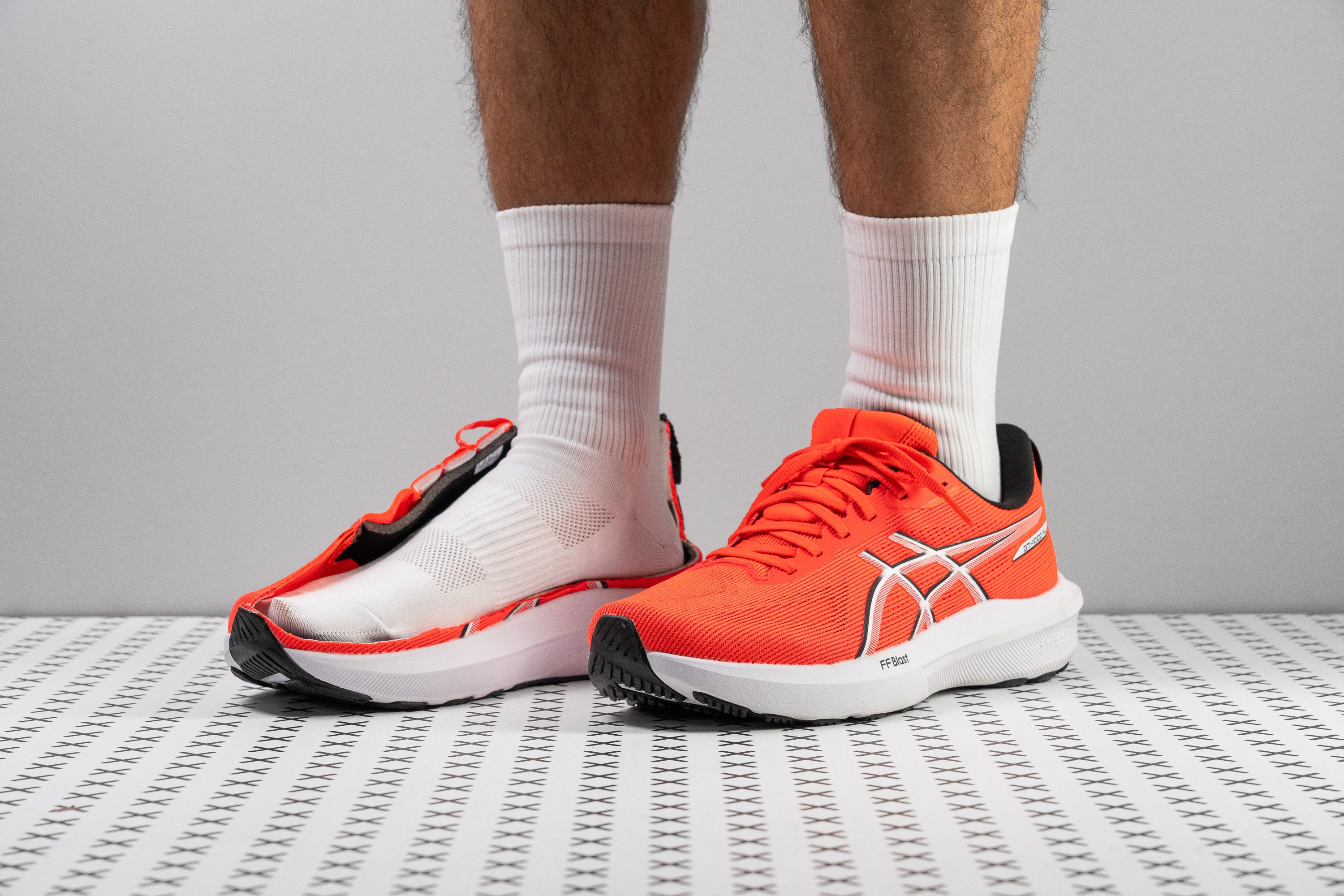Our verdict
- Top pick in best running shoes for flat feet
- Top pick in best stability running shoes
Pros
- Supercharged stability
- Ideal for heel strikers
- Still offers amazing value
- Fuss-free, durable design
- Improved outsole traction
- Comfortable for everyday wear
- Great step-in feel
- Improved foam from v13
Cons
- Bad breathability
- Still lacks energy return
- Boring ride
Audience verdict
Comparison
The most similar running shoes compared
+ + Add a shoe | |||||
|---|---|---|---|---|---|
| Audience score | 80 Good! | 82 Good! | N/A | 84 Good! | |
| Price | £115 | £140 | £170 | £130 | |
| Pace | Daily running | Daily running | Daily running | Daily running | |
| Shock absorption | Moderate | High | Moderate | High | |
| Energy return | Low | Moderate | High | Moderate | |
| Traction | High | High | High | Moderate | |
| Arch support | Stability | Stability | Stability | Stability | |
| Weight lab Weight brand | 9.6 oz / 272g 9.3 oz / 265g | 9.5 oz / 269g 9.4 oz / 266g | 9.3 oz / 264g 9.5 oz / 269g | 10.4 oz / 296g 10.5 oz / 298g | |
| Drop lab Drop brand | 9.6 mm 8.0 mm | 8.7 mm 8.0 mm | 10.1 mm 8.0 mm | 10.1 mm 10.0 mm | |
| Strike pattern | HeelMid/forefoot | HeelMid/forefoot | Heel | Heel | |
| Size | Slightly small | True to size | - | Slightly small | |
| Midsole softness | Soft | Soft | Soft | Soft | |
| Difference in midsole softness in cold | Normal | Normal | Small | Small | |
| Toebox durability | Decent | Decent | Decent | Decent | |
| Heel padding durability | Good | Good | Decent | Good | |
| Outsole durability | Good | Good | Good | Good | |
| Breathability | Warm | Warm | Warm | Moderate | |
| Width / fit | Medium | Medium | Narrow | Medium | |
| Toebox width | Medium | Narrow | Narrow | Medium | |
| Stiffness | Moderate | Moderate | Moderate | Moderate | |
| Torsional rigidity | Stiff | Stiff | Stiff | Stiff | |
| Heel counter stiffness | Moderate | Stiff | Stiff | Moderate | |
| Heel lab Heel brand | 35.4 mm 34.5 mm | 36.9 mm 36.5 mm | 36.8 mm 33.0 mm | 36.1 mm 38.0 mm | |
| Forefoot lab Forefoot brand | 25.8 mm 26.5 mm | 28.2 mm 28.5 mm | 26.7 mm 25.0 mm | 26.0 mm 28.0 mm | |
| Widths available | NormalWideX-Wide | NormalWideX-Wide | Normal | NormalWideX-Wide | |
| Orthotic friendly | ✓ | ✓ | ✓ | ✓ | |
| Season | All seasons | All seasons | All seasons | All seasons | |
| Removable insole | ✓ | ✓ | ✓ | ✓ | |
| Ranking | #307 Bottom 17% | #278 Bottom 25% | #201 Bottom 45% | #247 Bottom 33% | |
| Popularity | #153 Top 42% | #66 Top 18% | #138 Top 38% | #52 Top 14% |
Who should buy
The ASICS GT 1000 14 is a solid pick for runners who:
- Want a no-fuss stability daily trainer with top durability and an affordable price.
- Upgrade their GT 1000 every one or two years. This version keeps the same feel with thoughtful improvements like better shock absorption.
- Like the GT 2000 but prefer a more budget-friendly option. Well, thanks to the foam update, the GT 1000 it’s closer than ever.
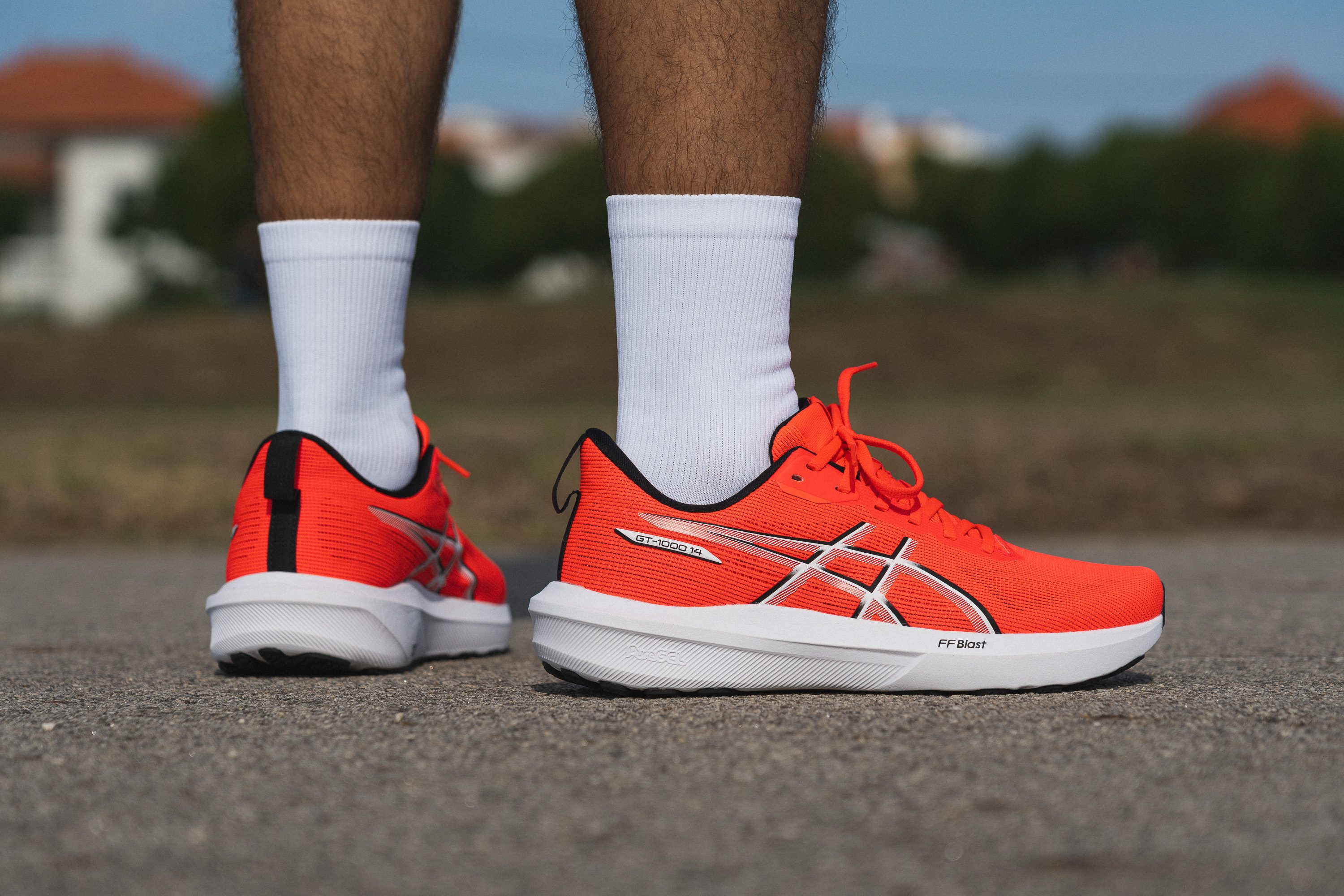
Who should NOT buy
The engineered mesh upper doesn’t meet the needs of runners training in warm climates, as we found that it lacks proper airflow and traps heat during runs. In our tests, the Saucony Guide 18 and the ASICS Gel Kayano 31 felt cooler and more breathable, although they also will hit harder on your wallet.
We also found in the lab that the GT 1000 14 also falls short in energy return. Its EVA-based FF Blast midsole lacks responsiveness. If you're after a bounce-filled ride, we suggest the Adidas Supernova Solution, because its PEBA foam is much better in terms of performance.
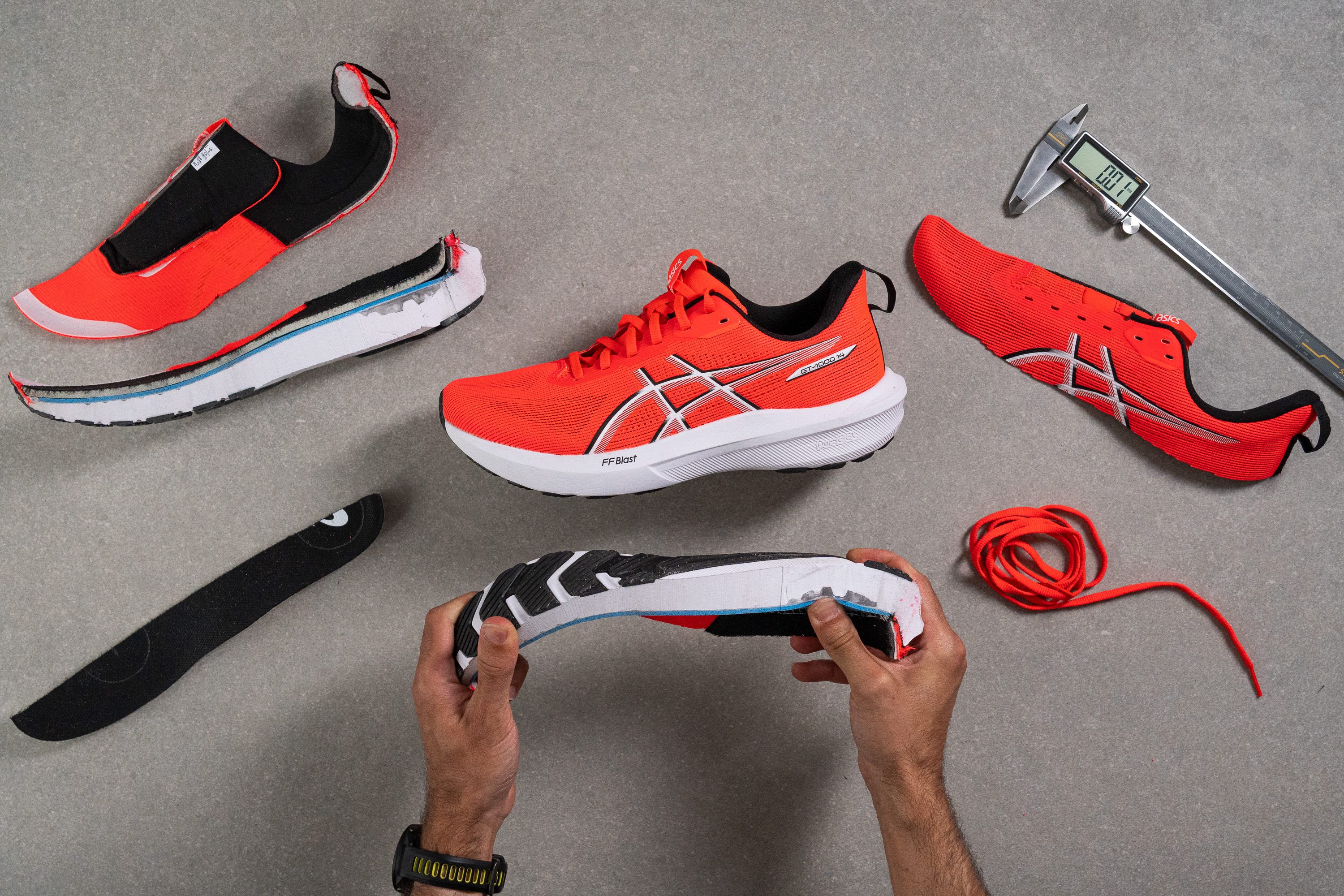
Cushioning
Shock absorption
This isn't a max-stack running shoe, so the 122 SA shock absorption result makes perfect sense. It's right around the average and should suit anyone looking for a shoe to handle short and moderate distances, up to 10 miles or so.

| GT 1000 14 | 122 SA |
| Average | 129 SA |
Energy return
With a 54.4% energy return, it lands on the lower end of our lab results. Since ASICS has often lagged in delivering top-tier cushioning in many daily trainers, we weren’t surprised by this outcome.
Still, it marks a clear improvement over its predecessor, which didn’t even reach the 50% mark in the same test.
| GT 1000 14 | 54.4% |
| Average | 58.5% |
Heel stack
Sure, it's not a max-stack shoe as mentioned earlier, but the GT 1000 keeps gaining height. Version 12 sat at 30.2 mm, while version 13 reached 33.7 mm in the heel. We measured 35.4 mm this time, which definitely makes a difference for heel strikers.
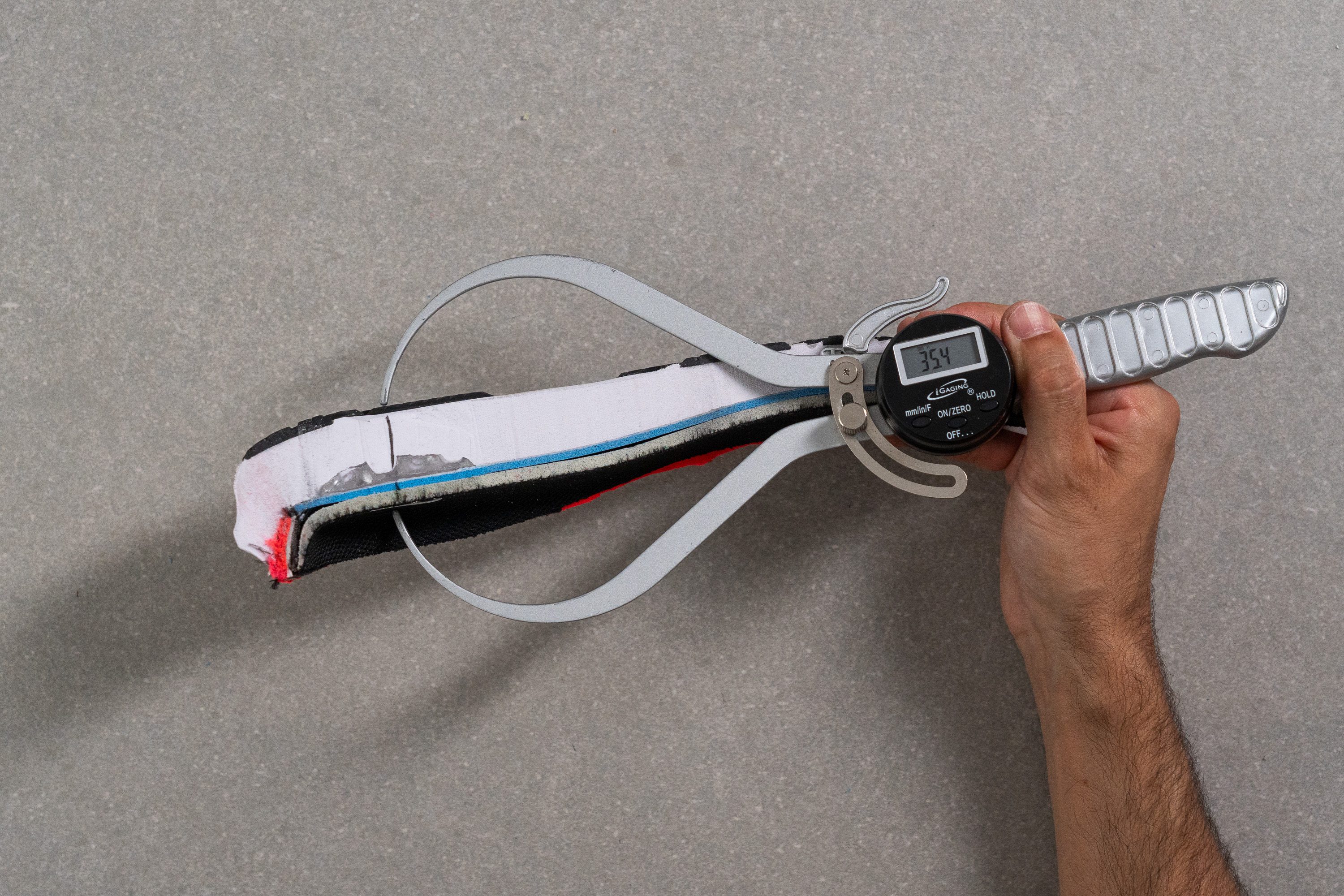
| GT 1000 14 | 35.4 mm |
| Average | 34.8 mm |
Forefoot stack
The forefoot came in at 25.8 mm, which makes this model a solid pick for runners seeking a balanced and beginner-friendly stability shoe.
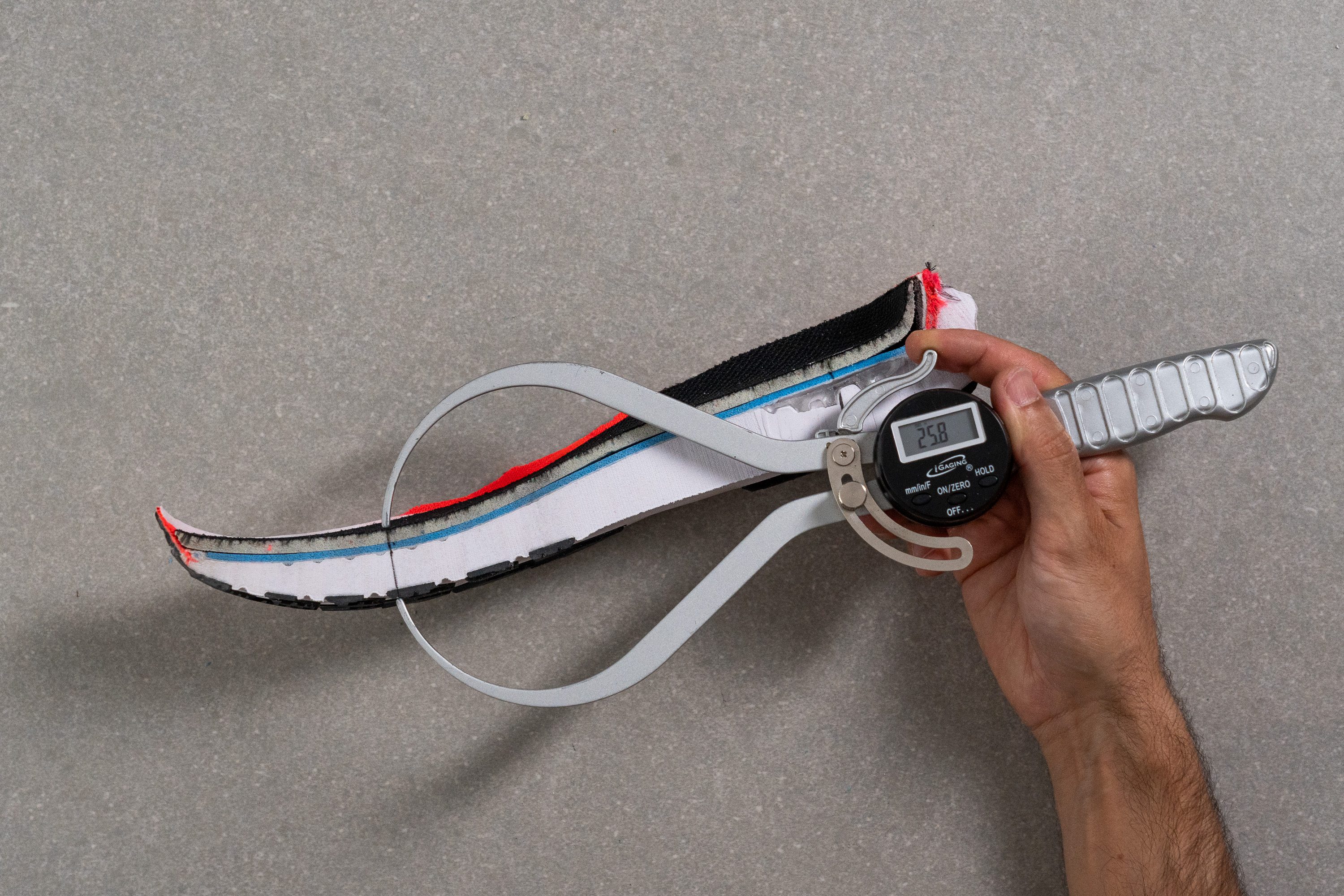
| GT 1000 14 | 25.8 mm |
| Average | 26.2 mm |
Drop
The GT 1000 14 is listed with an 8 mm drop, but we measured 9.6 mm.
That’s nearly a full centimetre of added foam in the heel compared with the forefoot, making this shoe better suited for beginners and heel strikers.
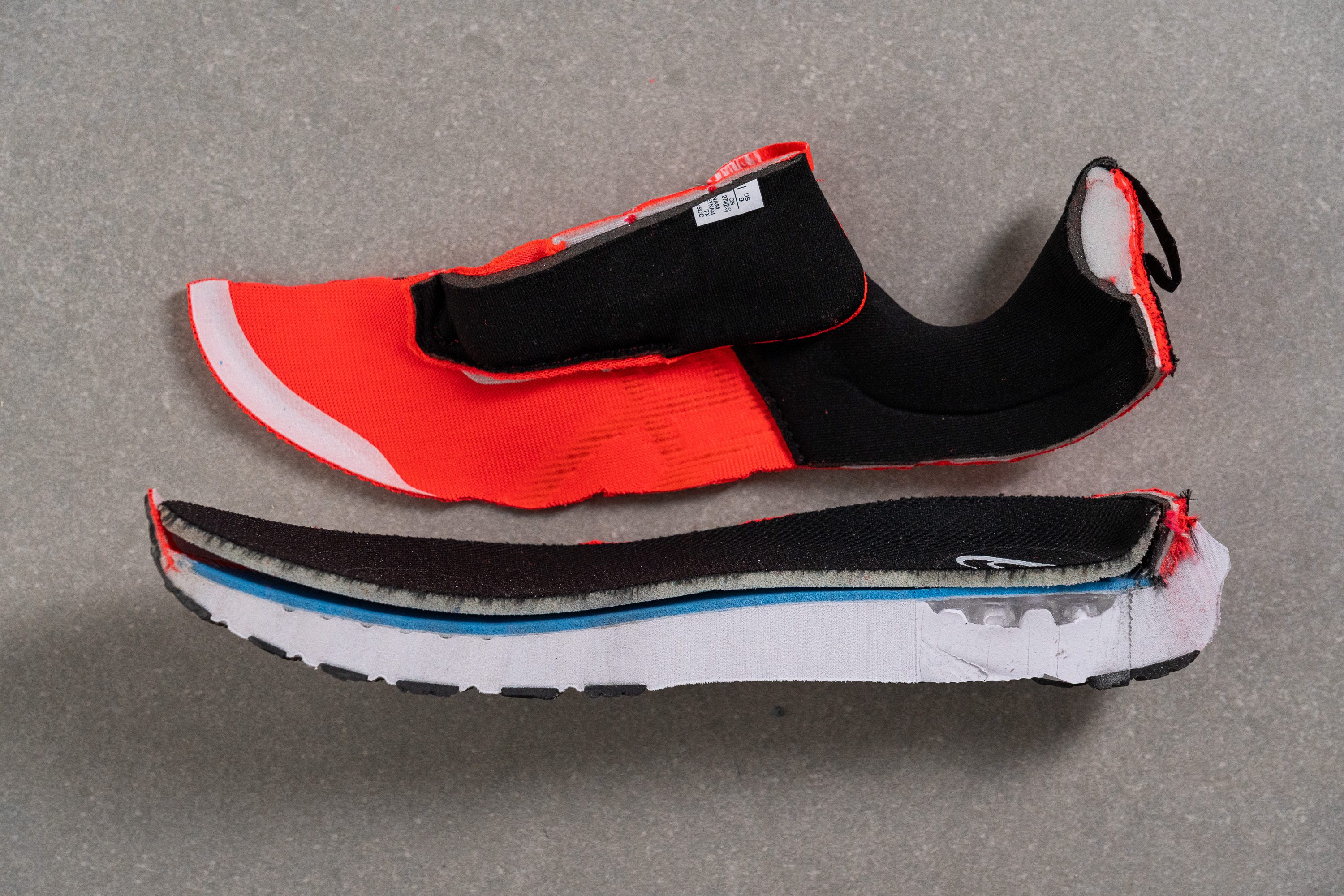
| GT 1000 14 | 9.6 mm |
| Average | 8.6 mm |
Midsole softness
One of the key updates in the GT 1000 14 is the switch to FF Blast in the midsole. It’s not a premium foam reserved for top-tier models, but it clearly outperforms the older FlyteFoam across the board and puts this model closer to the GT 2000 13.
We measured 19.4 HA on our durometer, a middle-of-the-road softness that matches the shoe’s overall no-surprises approach.
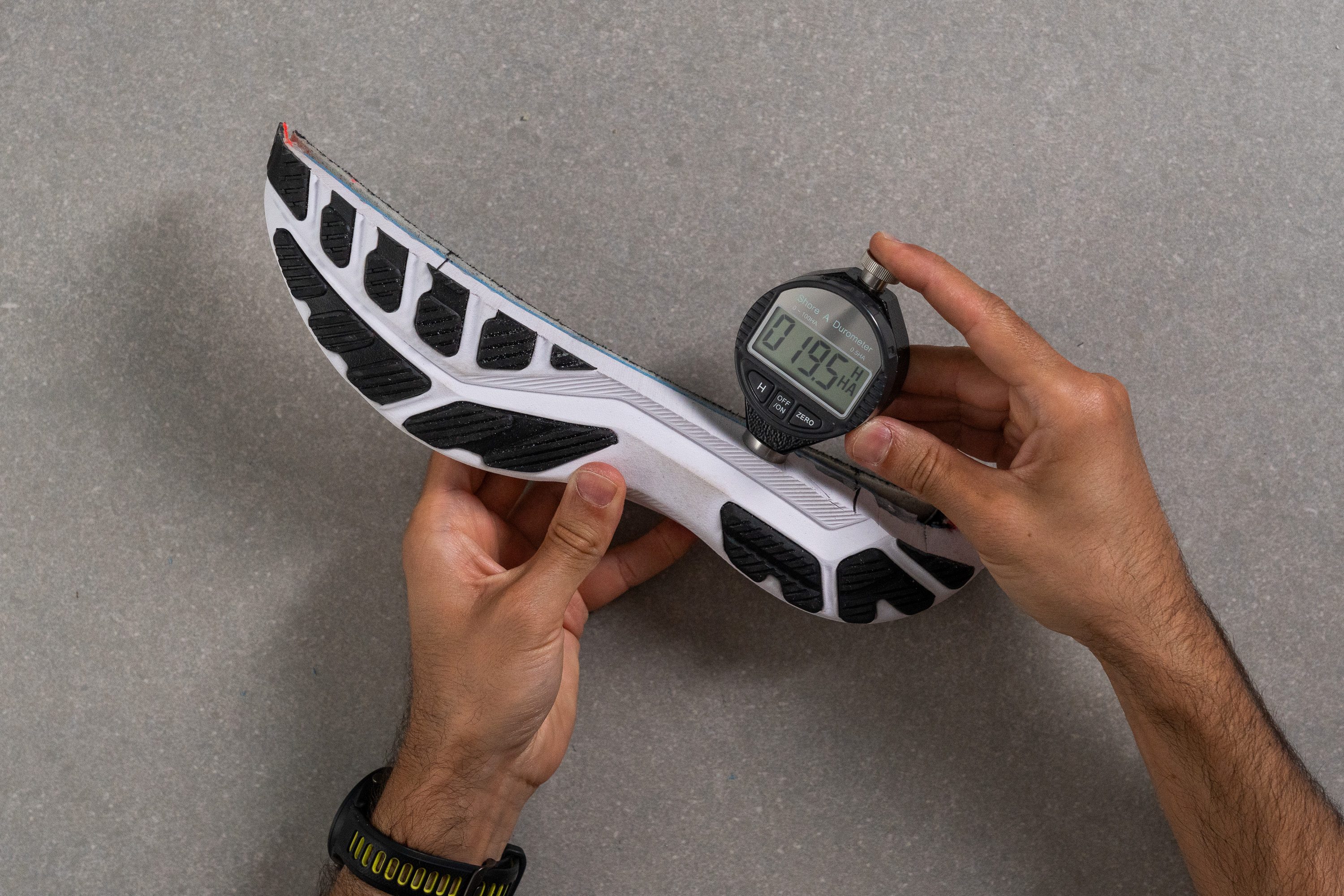
| GT 1000 14 | 19.4 HA |
| Average | 20.4 HA |
Rocker
Rockered shoes are everywhere these days, but it seems that there’s still room for more traditional designs. The GT 1000 14 sticks to that formula, with only a slight curve in the heel and forefoot. We think that’s great news for fans of the GT 1000.
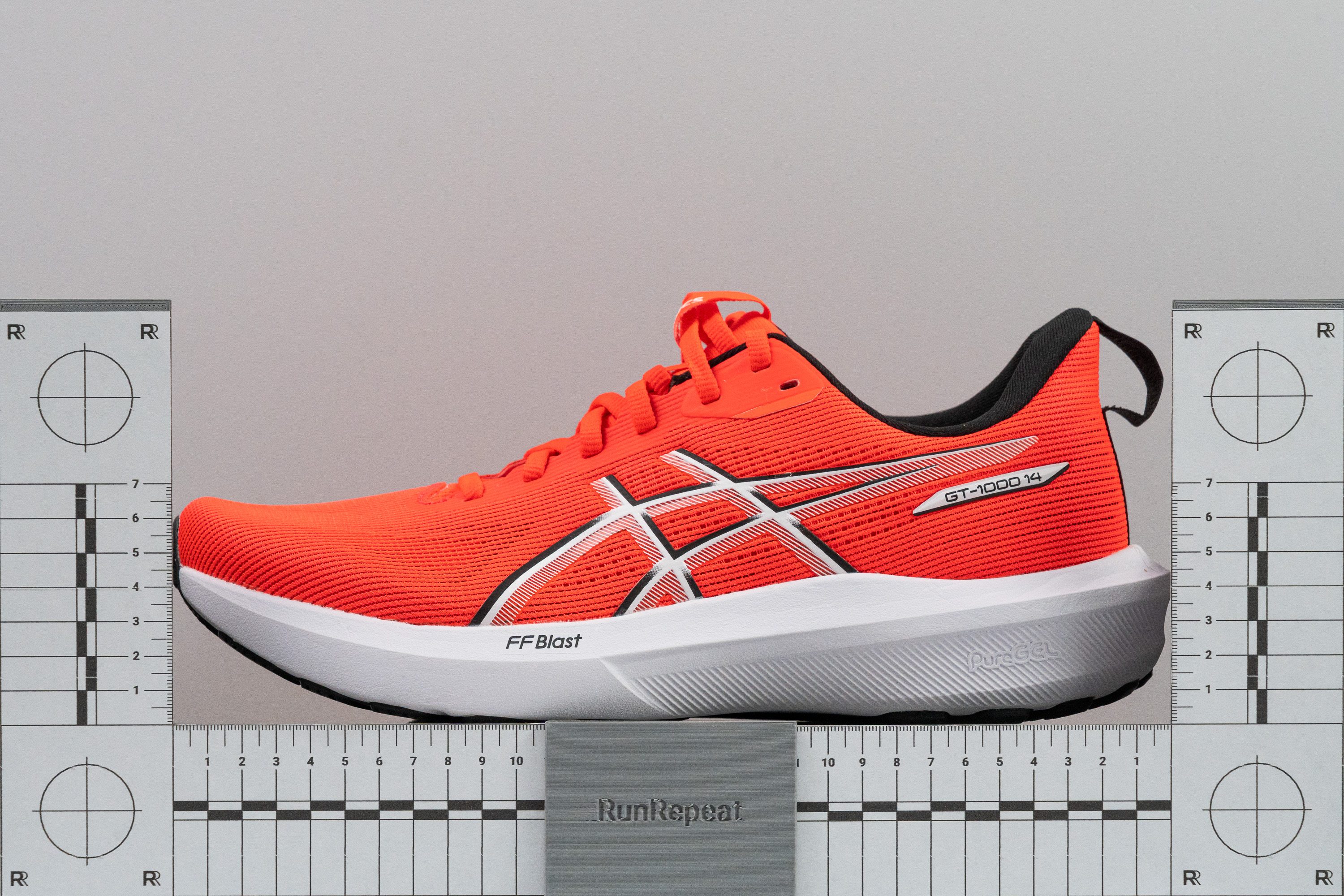
PureGEL
Although the GT 1000 doesn’t carry the “Gel” label like the Gel Nimbus 27 or Gel Cumulus 27, ASICS has still embedded a PureGEL unit in the heel to soften landings and boost comfort. But that comes with a trade-off, as this jelly-like material offers very little bounce and reduces energy return.
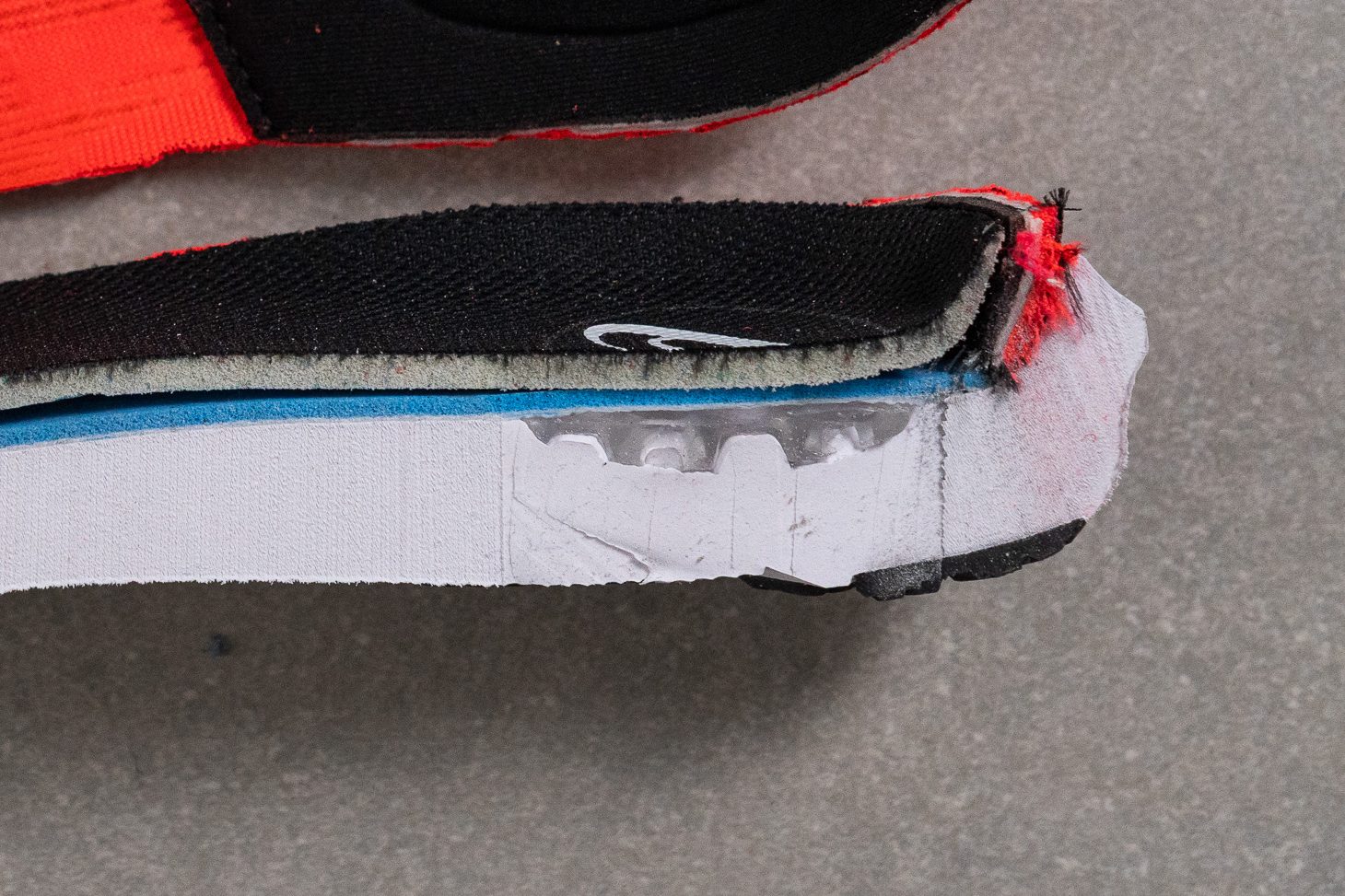
Size and fit
Size
ASICS GT 1000 14 fits slightly small (12 votes).
Width / Fit
We found the fit to be nearly identical to previous versions, though this update offers a touch more room across the upper.
When we tested it in the lab, we measured 97.5 mm at its widest point. That's ideal for runners with average or even slightly wide feet. And for those needing even more space, there's also a Wide version available in most markets.
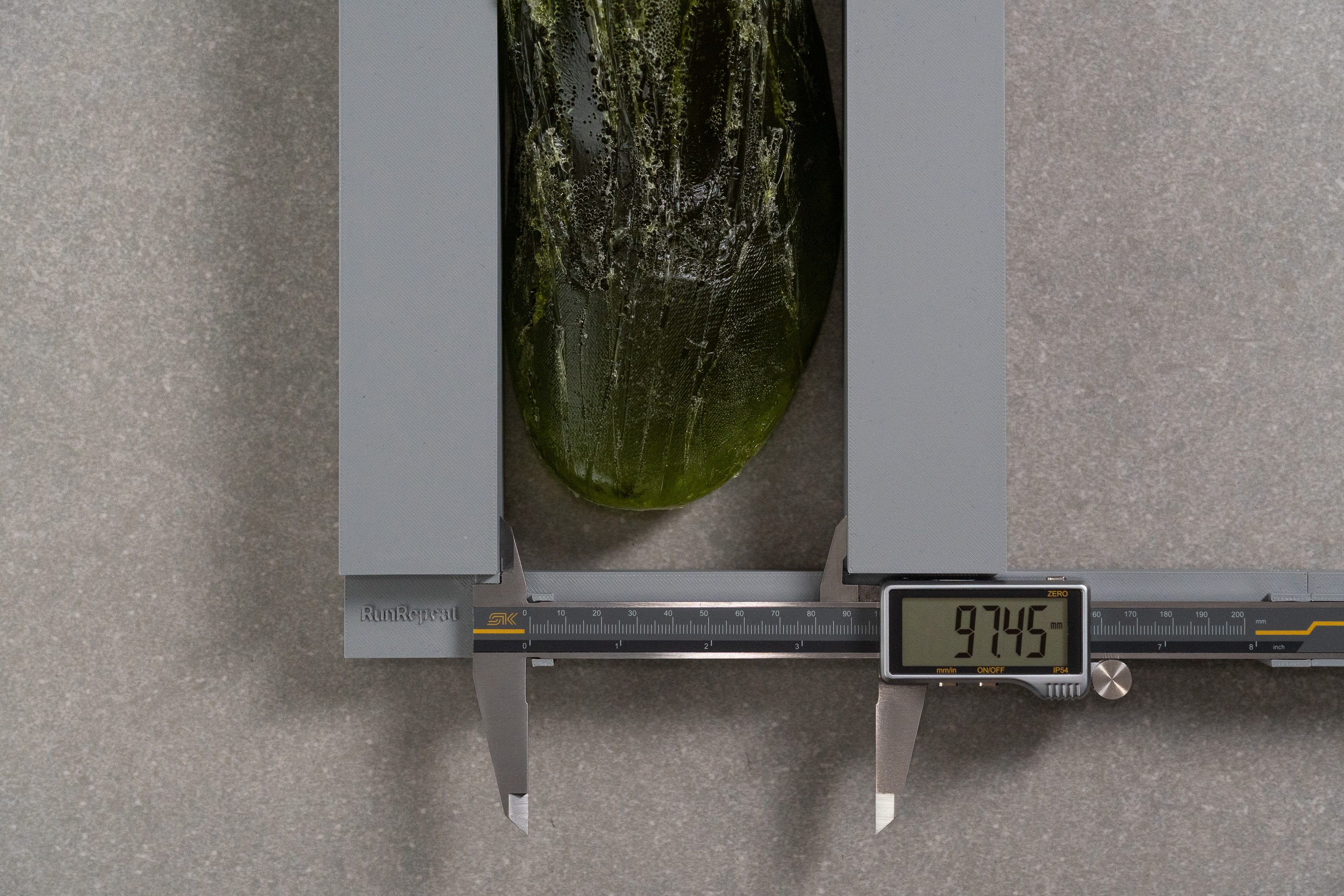
| GT 1000 14 | 97.5 mm |
| Average | 95.1 mm |
Toebox width
The toebox width also stays in line with previous versions. We measured 74.1 mm, which offers enough space to avoid toe squeeze, though it’s far from the roomy, foot-shaped design you’d find in an Altra or Topo.

| GT 1000 14 | 74.1 mm |
| Average | 73.3 mm |
Toebox height
If there's a slightly snugger area, it's the toebox height, which measured about 1 mm below average.
But during our test runs, we didn’t experience any discomfort or unwanted pressure in this zone.
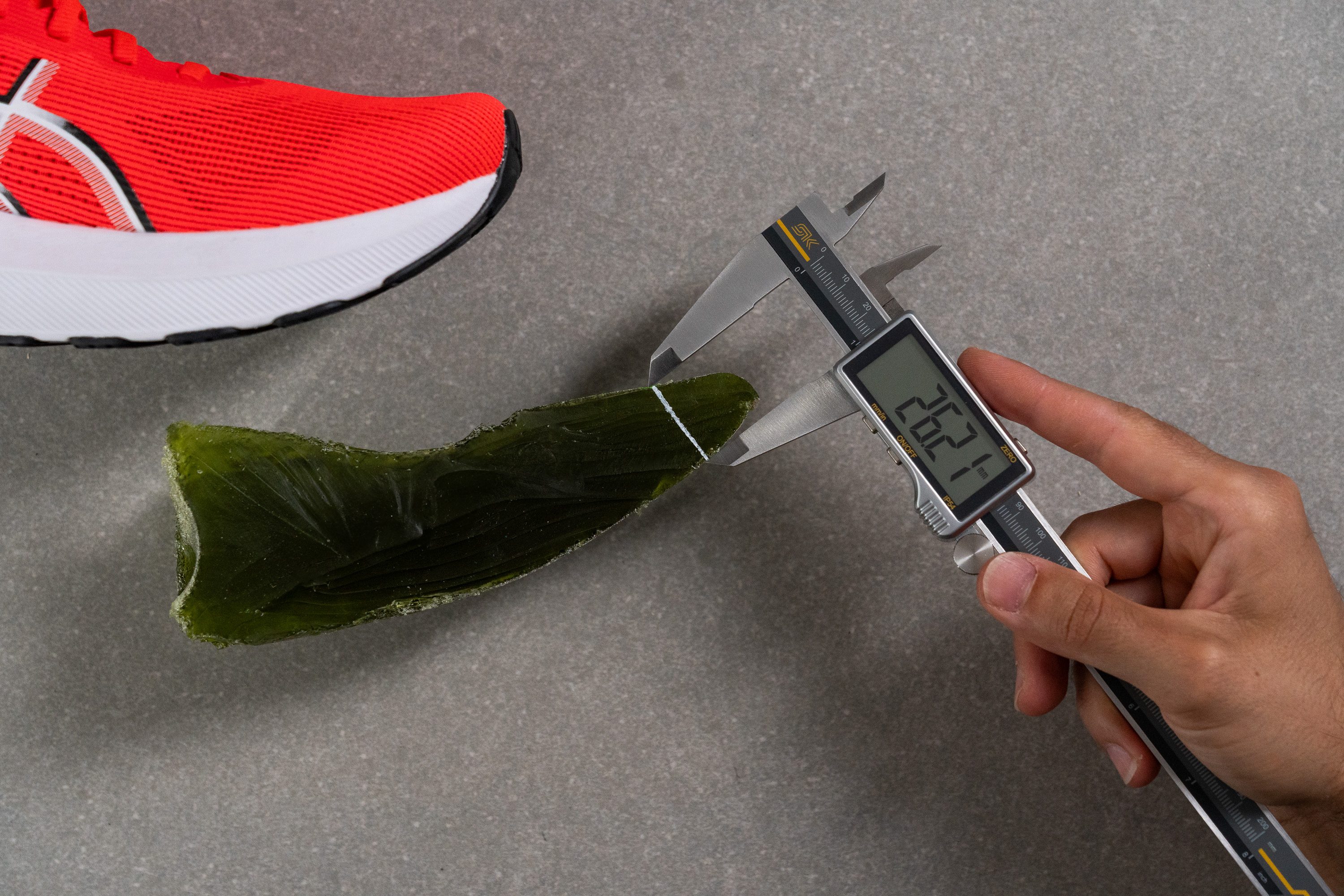
| GT 1000 14 | 26.2 mm |
| Average | 27.1 mm |
Traction / Grip
Traction test
We’re glad to report that the GT 1000 14 comes with a grip-ready outsole scoring 0.50, a major upgrade from the GT 1000 13 (0.35). Whether you're running in the rain or on dry roads, version 14 confirms reliable, all-season traction.
| GT 1000 14 | 0.50 |
| Average | 0.48 |
Outsole design
The GT 1000 14 outsole features segmented AHAR (ASICS High Abrasion Rubber) in high-wear zones like the heel, forefoot, and outer edge. The lugs feature deep flex grooves, helping the shoe bend more naturally. The rubber areas are separated by exposed EVA foam, which is visible through several midfoot cutouts and central channels.
The rubber coverage is generous overall and protects the midfoot area well, but strategic cutouts help reduce weight and allow the foam to compress more freely.

Flexibility / Stiffness
We tested the GT 1000 14 flexibility in our lab and found it reached the 30-degree bend point with just 12.3N of force. That result confirms what we expected from a shoe meant to feel more natural underfoot than the average modern, thickly-stacked trainer.
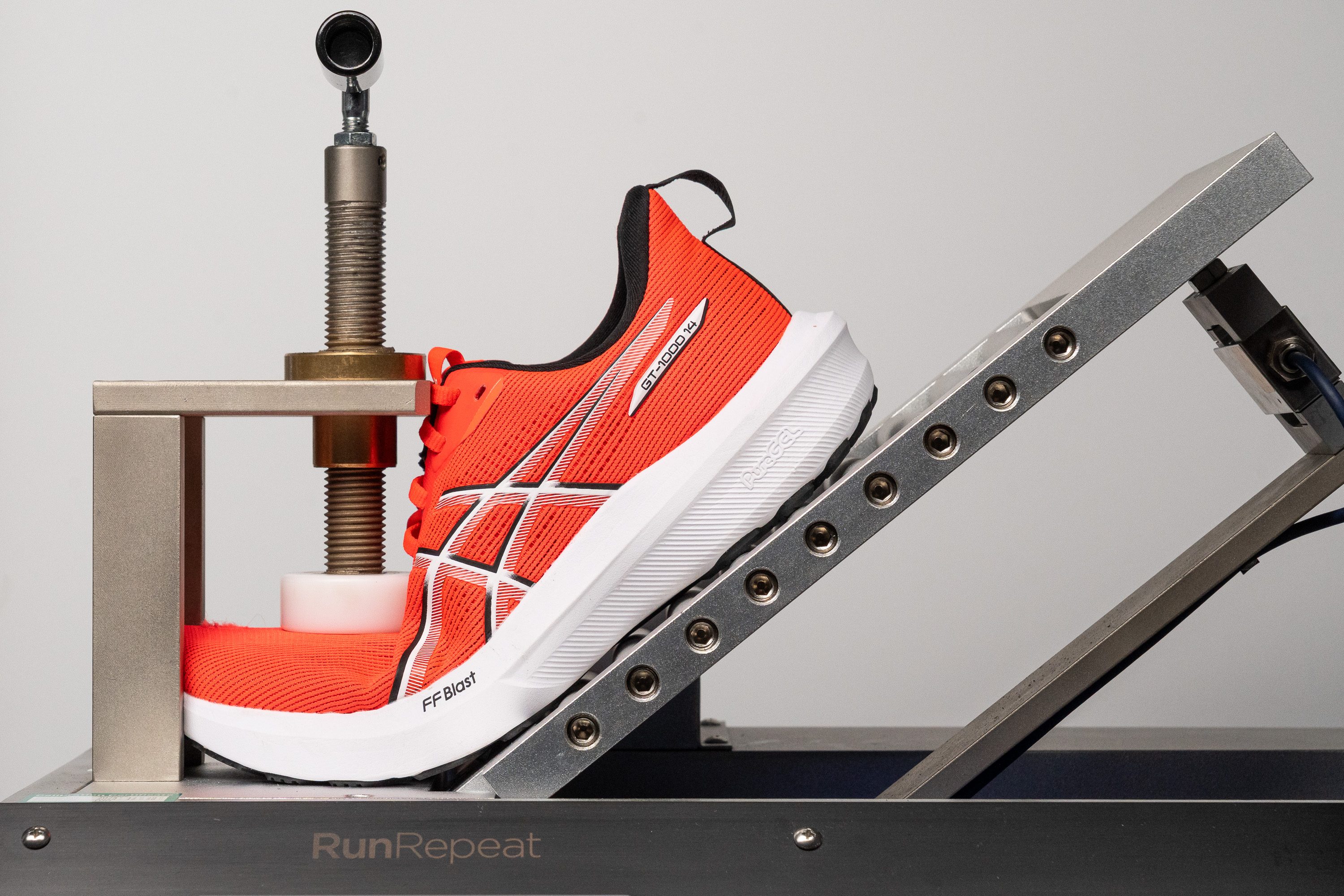
| GT 1000 14 | 12.3N |
| Average | 15.3N |
Weight
We put the GT 1000 14 on our scale and discovered it weighs nearly the same as its predecessor, with a barely noticeable 1.5% drop. The final reading was 9.6 oz or 272g, right around average and fully within a reasonable range.
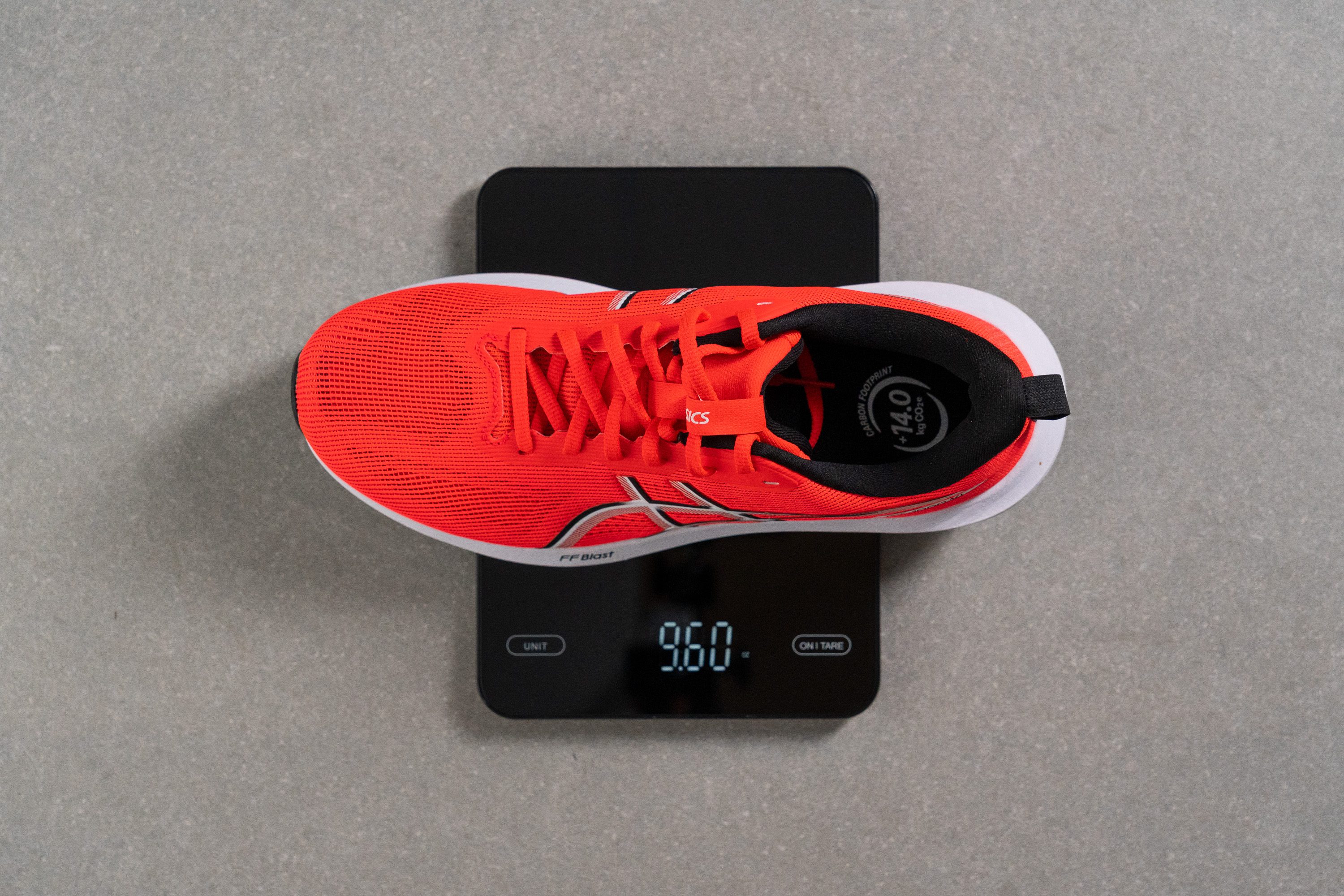
| GT 1000 14 | 9.6 oz (272g) |
| Average | 9.3 oz (264g) |
Breathability
Running shoes in the budget-friendly category often come with trade-offs in energy return, weight, grip, or breathability. In our testing, we found that airflow is one of the weakest aspects of the GT 1000 14.
Using our smoke machine, we saw that the engineered mesh held back nearly everything, scoring just 2/5. For runners in hot climates, that could make summer sessions uncomfortable.
To double-check, we moved the upper across a strong light source and clearly saw the lack of ventilation holes. That limited airflow is what makes the shoe feel warmer than expected.
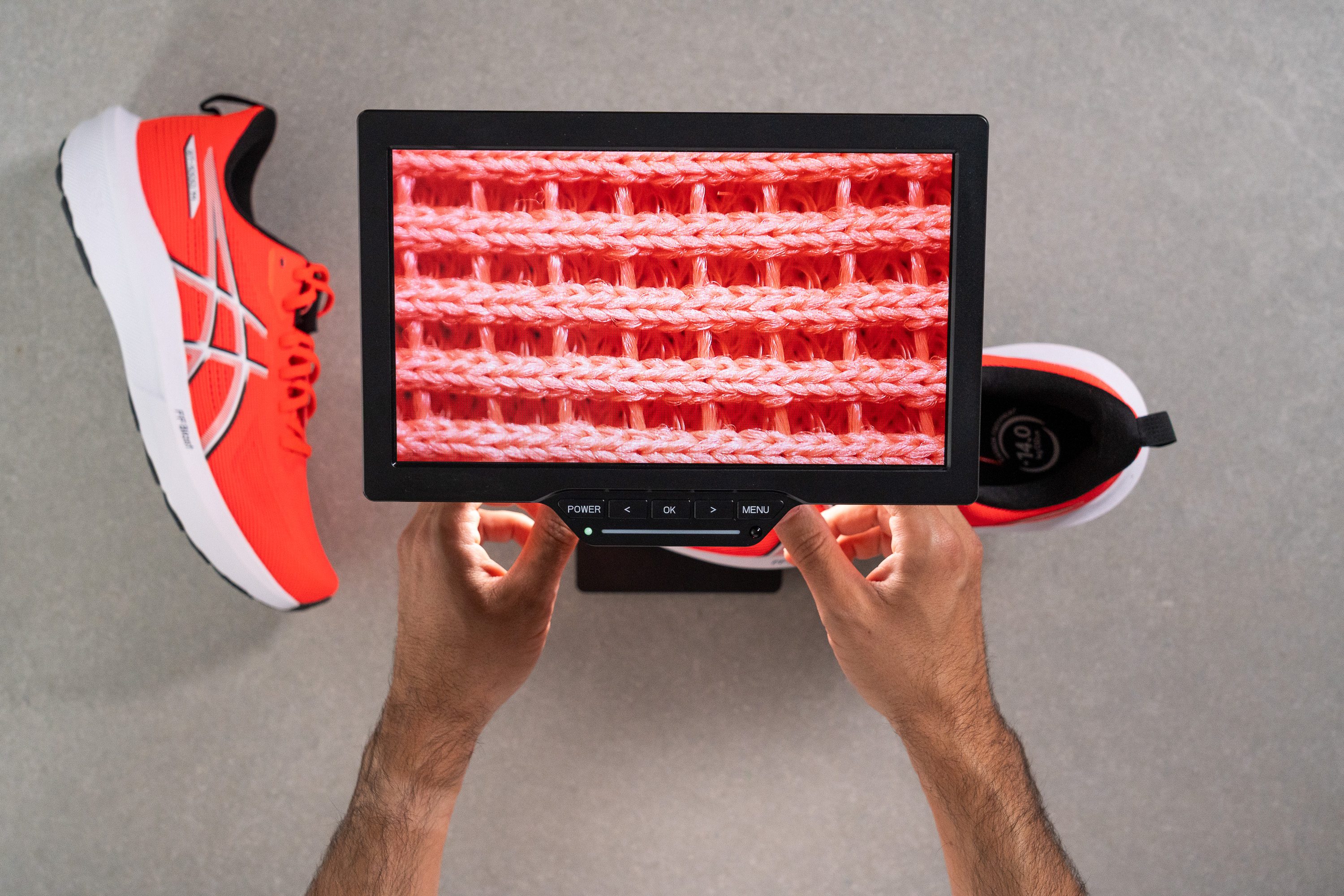
Under our digital microscope, the tight weave of the mesh confirmed it: there’s very little room for air to pass through.
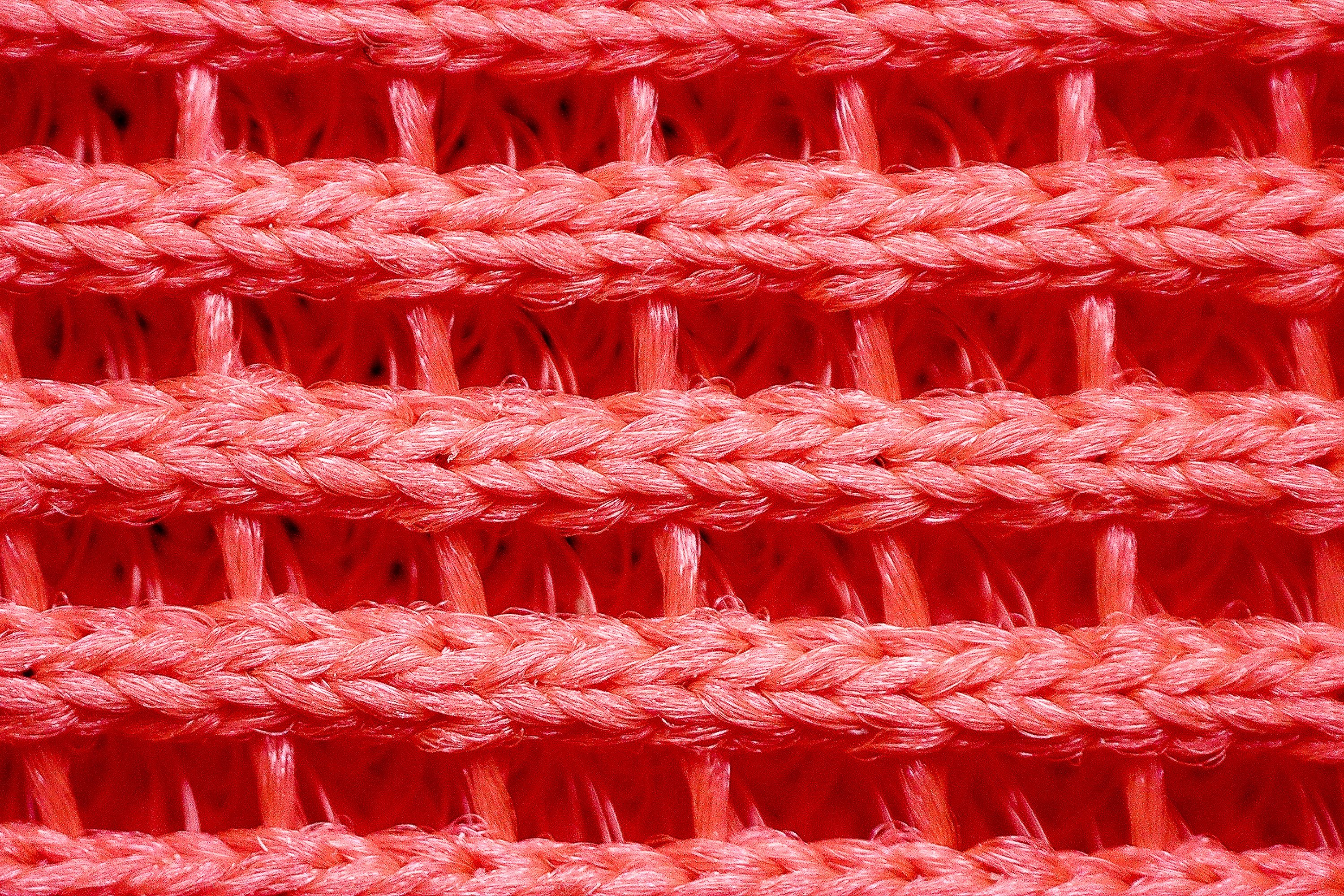
From a comfort perspective, the upper feels good, especially around the heel, as ASICS added thick foam padding back there. And while low breathability it’s not a dealbreaker at this price for most runners, we think the upper could definitely benefit from improved ventilation for version 15.
| GT 1000 14 | 2 |
| Average | 3.7 |
Stability
Lateral stability test
We tested the GT 1000 14 and found it's purpose-built to deliver reliable stability. In fact, we think it's an ideal daily trainer for runners who need more support than an average neutral model like the Versablast 4.
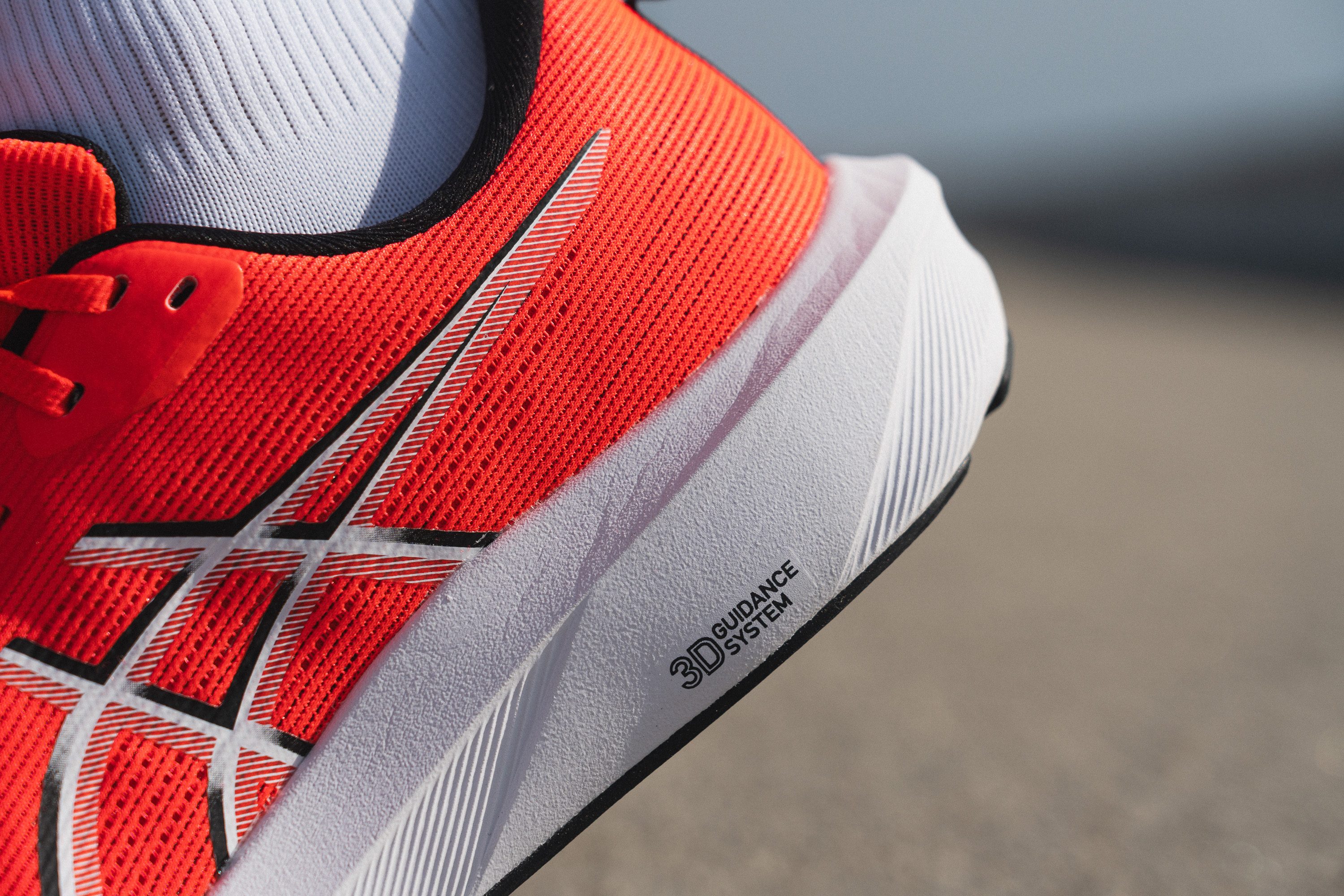
ASICS delivers this through a mix of smart design choices: a 3D Guidance System with stiffer arch structure, high-rising midsole walls, and a a broad heel.
Torsional rigidity
This shoe is also more rigid than the average running model, so don’t expect it to flex like your yoga teacher. We tested its flexibility and had a tough time bending it, which led us to rate it 4/5.
| GT 1000 14 | 4 |
| Average | 3.5 |
Heel counter stiffness
The heel counter feels similar to what we’ve seen in other daily trainers, earning a 3/5 for offering a fair balance between support and comfort. We were actually a bit surprised it’s not ultra-rigid, especially considering the generous heel foam.
| GT 1000 14 | 3 |
| Average | 2.9 |
Midsole width - forefoot
Despite being a stability shoe at heart, ASICS kept the forefoot width at 113.6 mm. For us, that's a clear sign that the design favours heel strikers more than midfoot or forefoot runners.
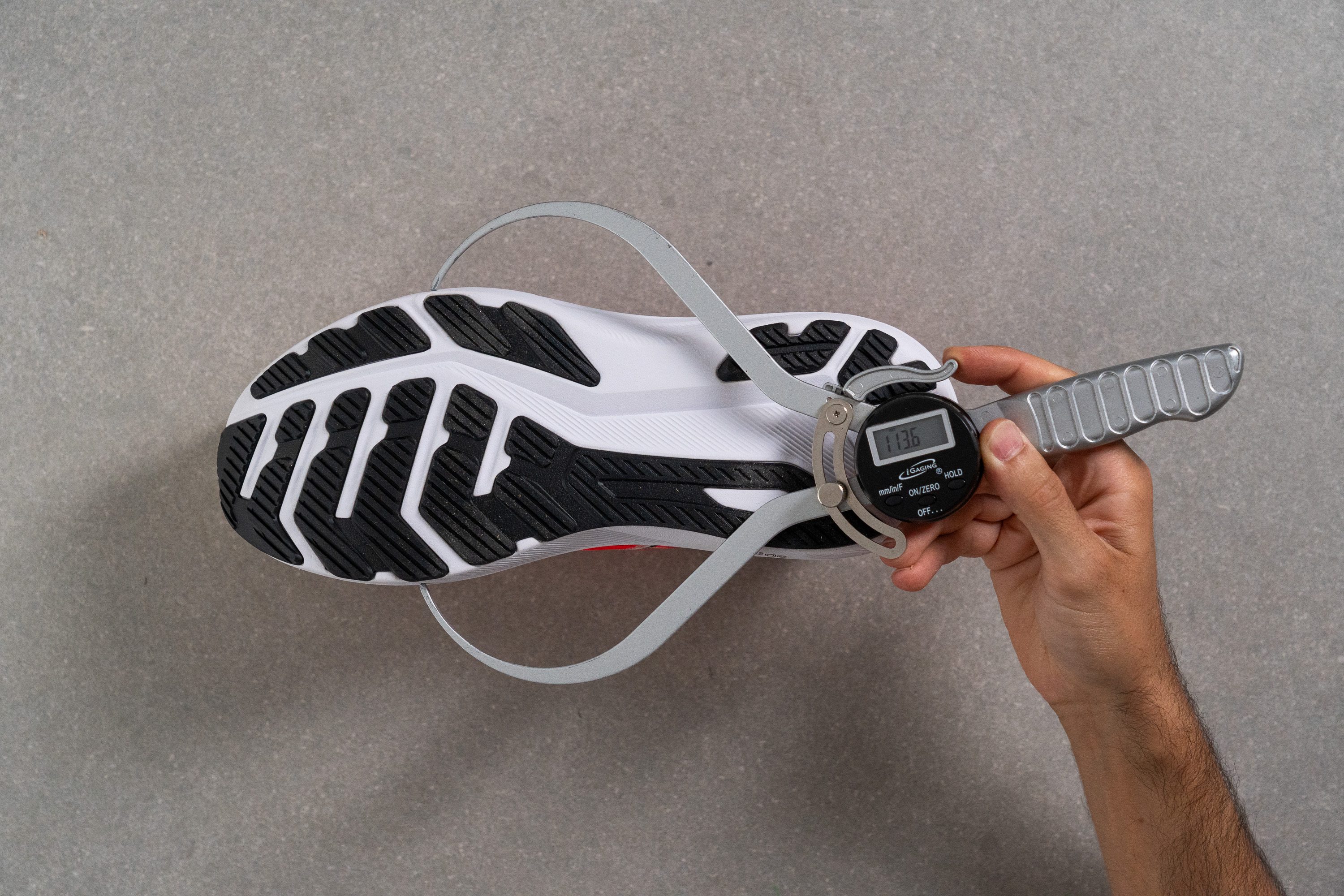
| GT 1000 14 | 113.6 mm |
| Average | 114.4 mm |
Midsole width - heel
Especially because the heel is noticeably wider than the average at 94.8 mm, giving a clear stability boost in that zone. Like other recent ASICS support-focused models, the midfoot is also extra-wide and creates a boxy-looking midsole platform.

| GT 1000 14 | 94.8 mm |
| Average | 90.7 mm |
Durability
Toebox durability
While the missing ventilation holes hurt breathability, they do bring a side benefit: enhanced toebox durability. We gave it a 3/5 in our lab test, which suggests early wear and tear is not something most runners will deal with.
| GT 1000 14 | 3 |
| Average | 2.6 |
Heel padding durability
The heel padding ticks the box with a top-tier 5/5 score, which ensures that even runners who often wear holes in this area won’t be able to drill through this ultra-resilient setup.
| GT 1000 14 | 5 |
| Average | 3.4 |
Outsole durability
We’ve got good news from the outsole too, as our Dremel only managed to shave off 0.7 mm from the AHAR rubber. That’s an impressive result that clearly outperforms the average in our lab, confirming this outsole as both grippy and abrasion-resistant.
| GT 1000 14 | 0.7 mm |
| Average | 1.1 mm |
Outsole thickness
In fact, we believe the 4.5 mm outsole might be unnecessarily thick considering the solid durability of the AHAR rubber. Reducing it could lead to a more enjoyable ride and shave off some extra weight.
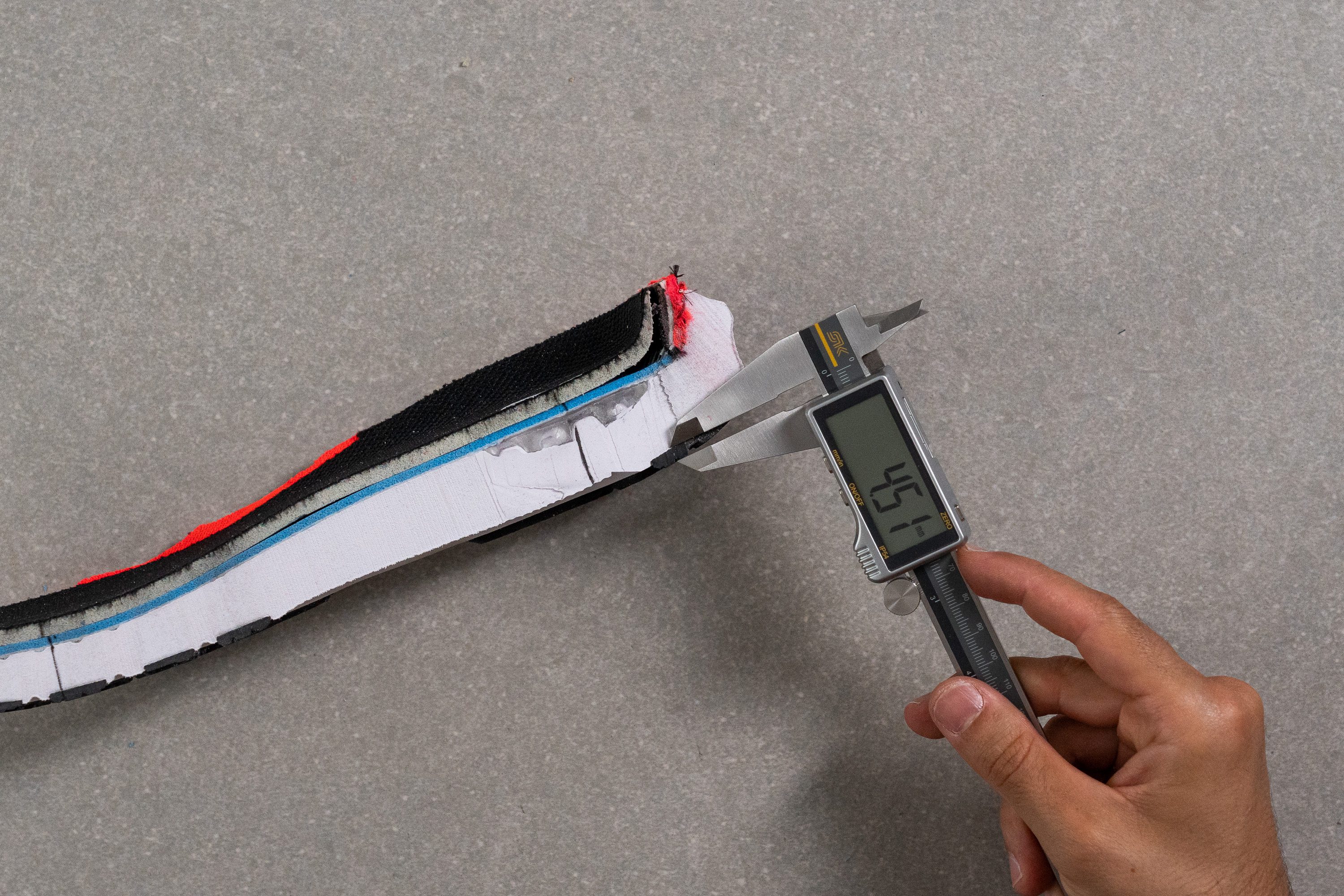
| GT 1000 14 | 4.5 mm |
| Average | 3.2 mm |
Misc
Insole thickness
The insole is thicker than average at 5.2 mm, adding a touch more underfoot cushioning than what we usually see in other daily trainers.
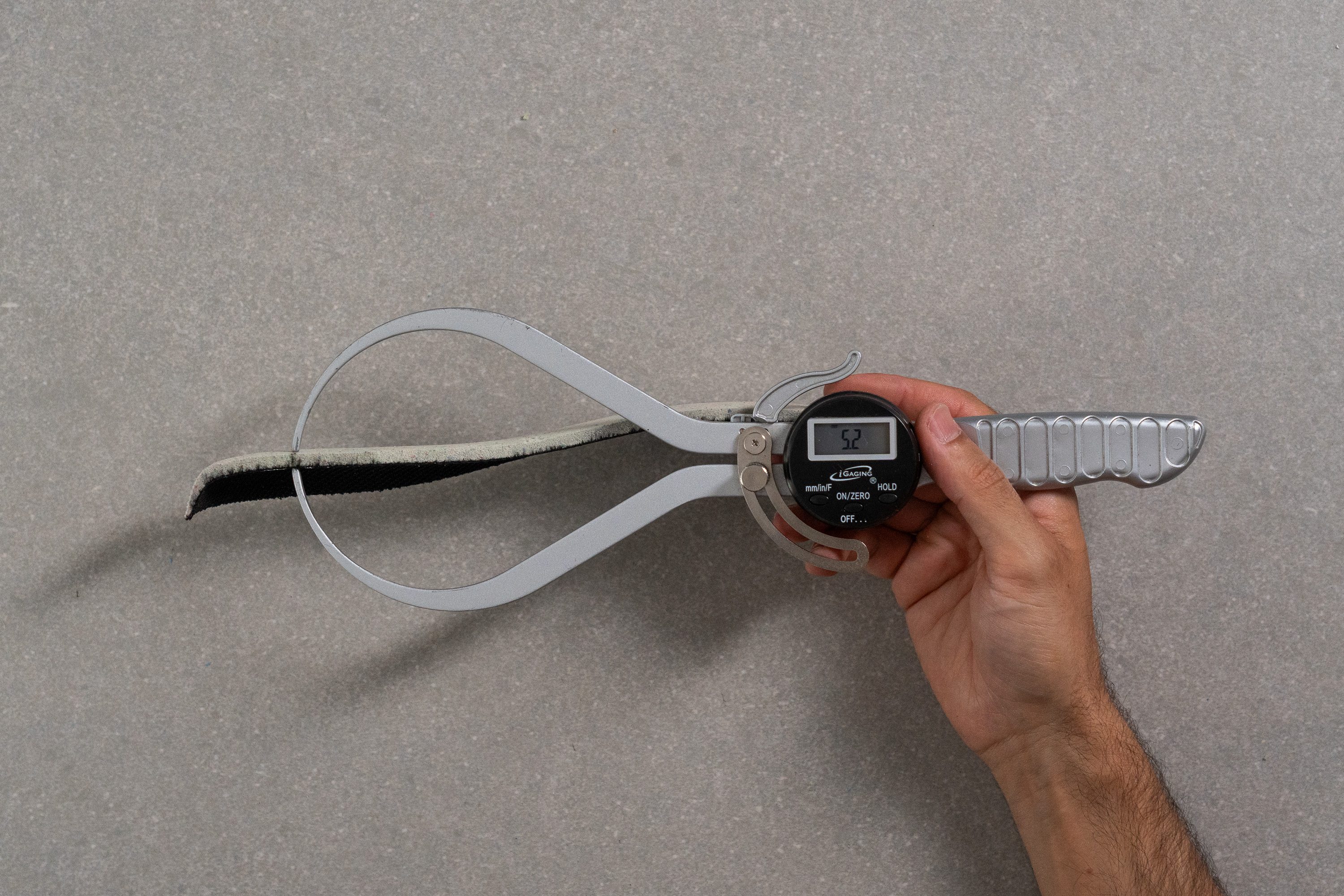
| GT 1000 14 | 5.2 mm |
| Average | 4.5 mm |
Removable insole
If you want to use a thinner insole or swap in your custom orthotics, there's no problem at all.
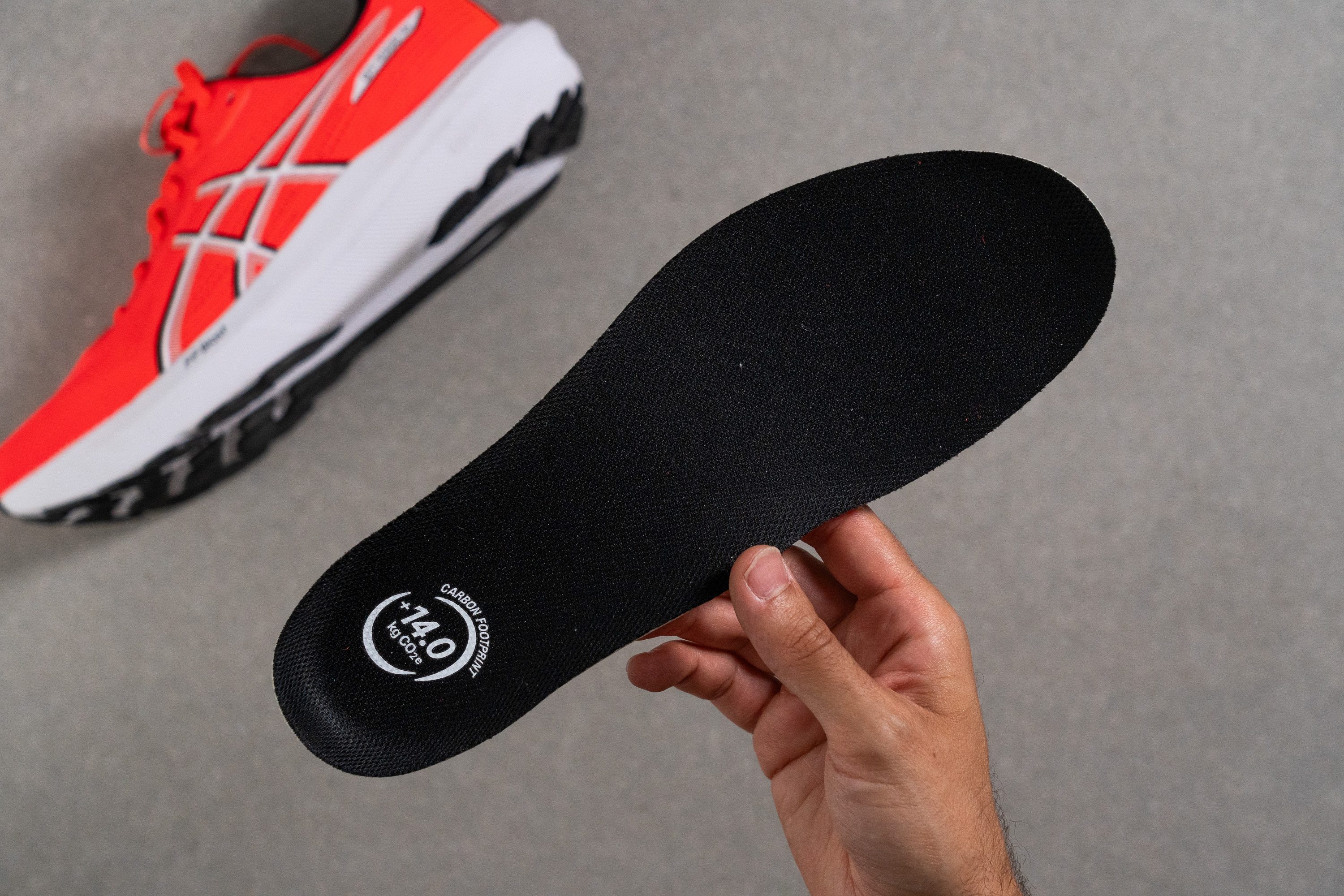
| GT 1000 14 | Yes |
Midsole softness in cold (%)
Despite being a step up from the previous foam, FF Blast is still an EVA-based. In our test, it got 39% firmer, which is quite noticeable.
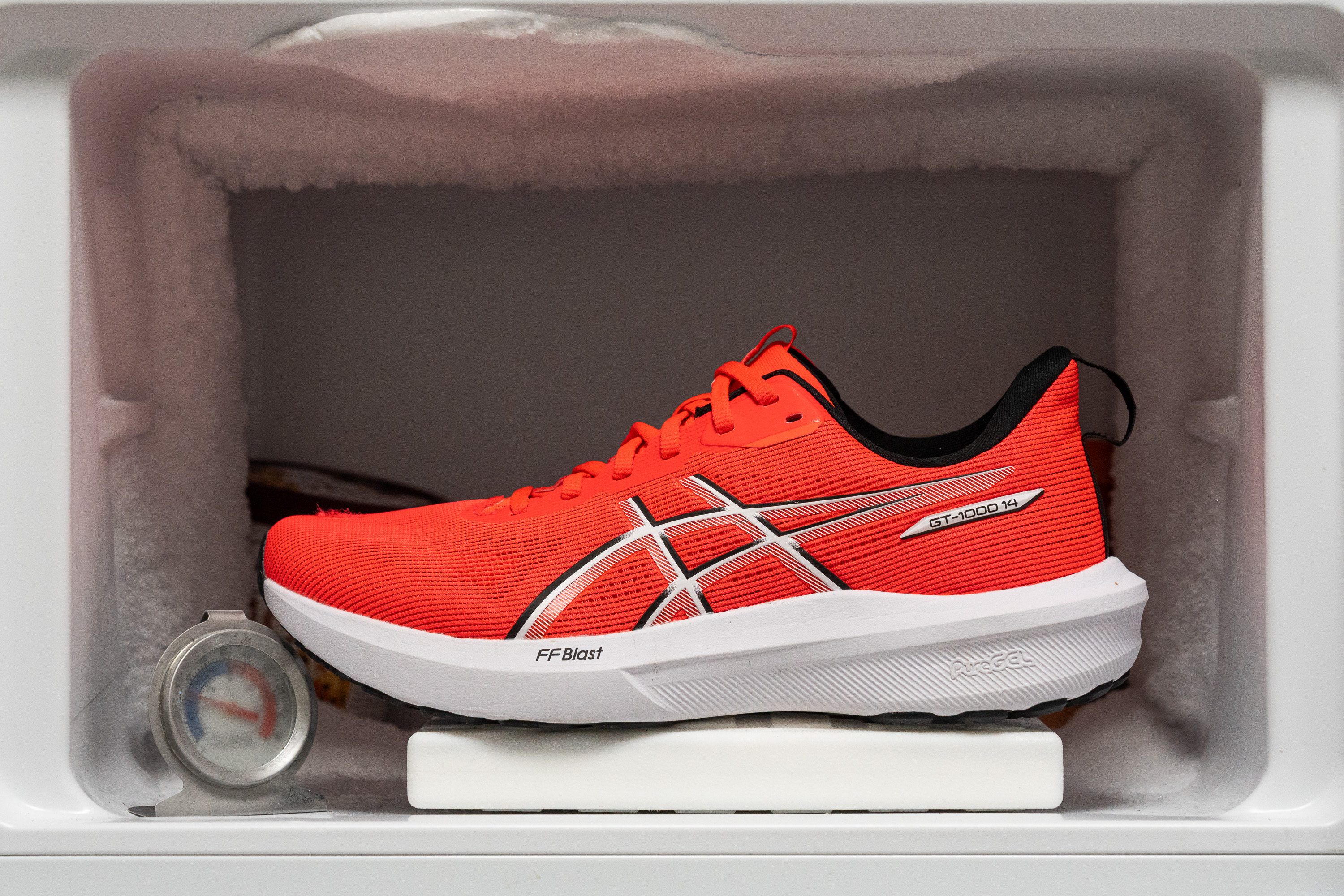
| GT 1000 14 | 39% |
| Average | 24% |
Reflective elements
The ASICS GT 1000 14 skips reflective elements entirely, a frequent omission in budget-friendly shoes.
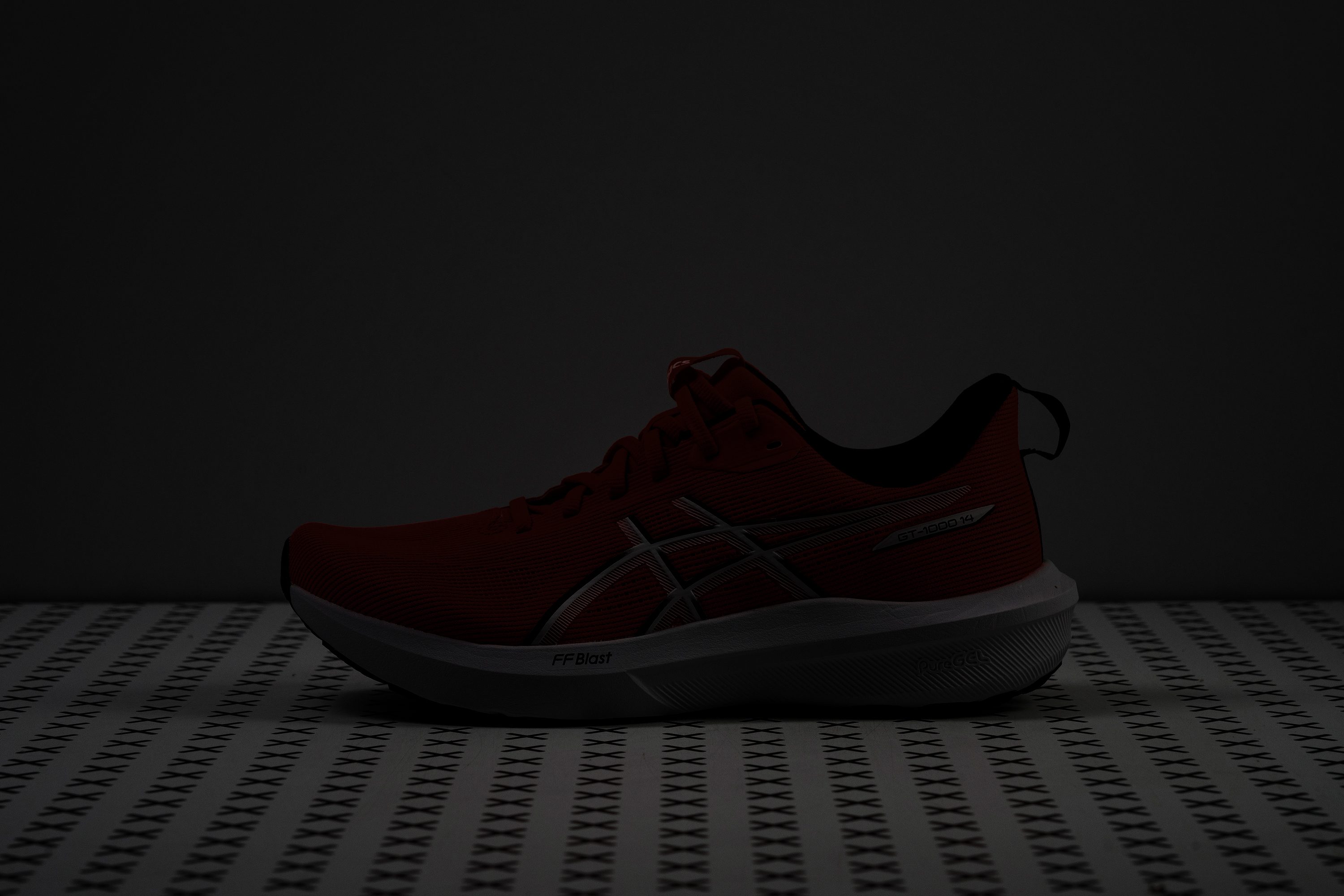
| GT 1000 14 | No |
Tongue padding
We noticed in the last two years that ASICS keeps thick tongues on budget-friendly shoes while going ultra-thin on higher-end models.
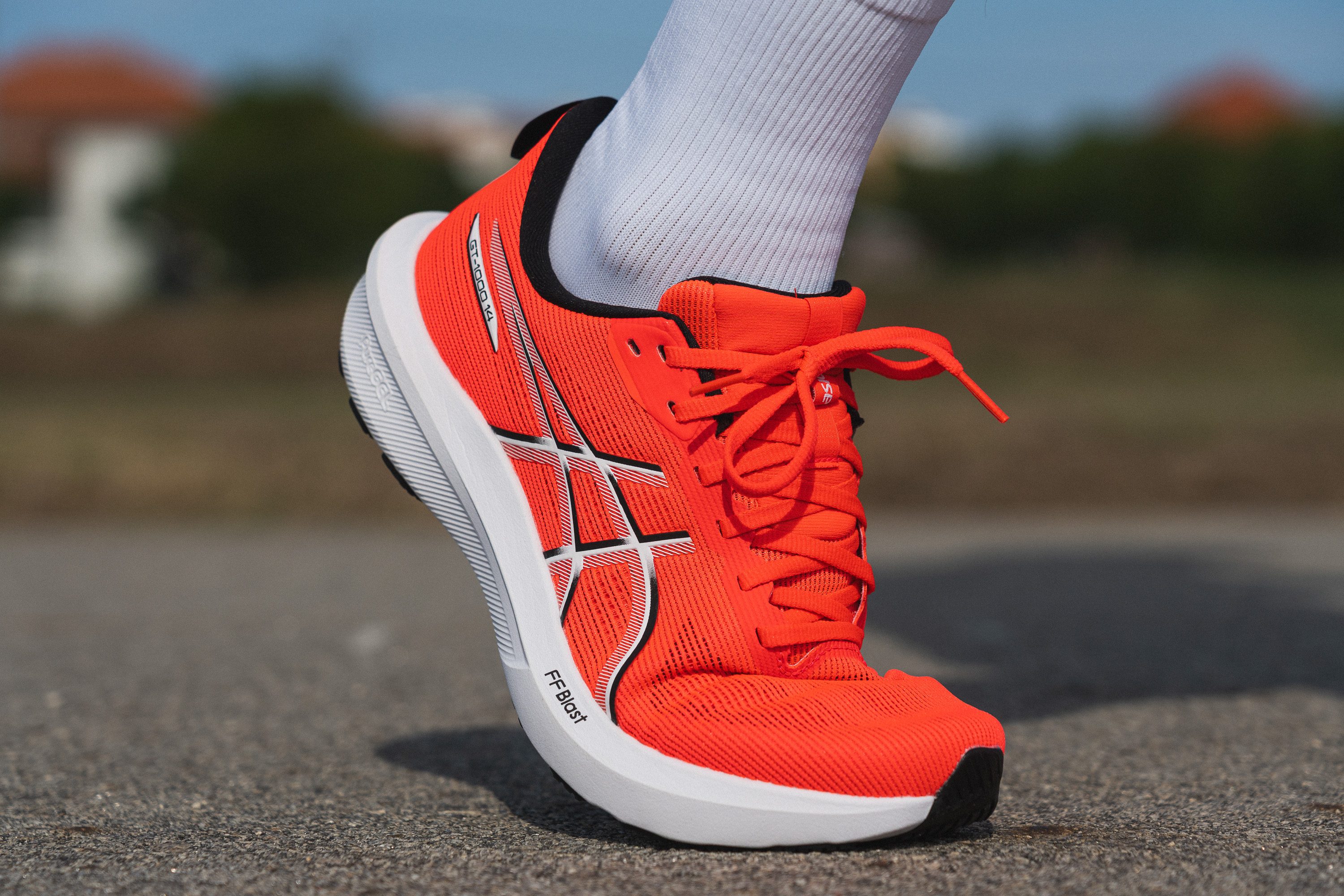
This version sticks with the same chunky 8.1 mm tongue from its predecessor, a weight-adding yet comfort-boosting choice that enhances the plush step-in feel. We also tested the lacing system, which uses basic punched eyelets without any fancy or overengineered solutions.
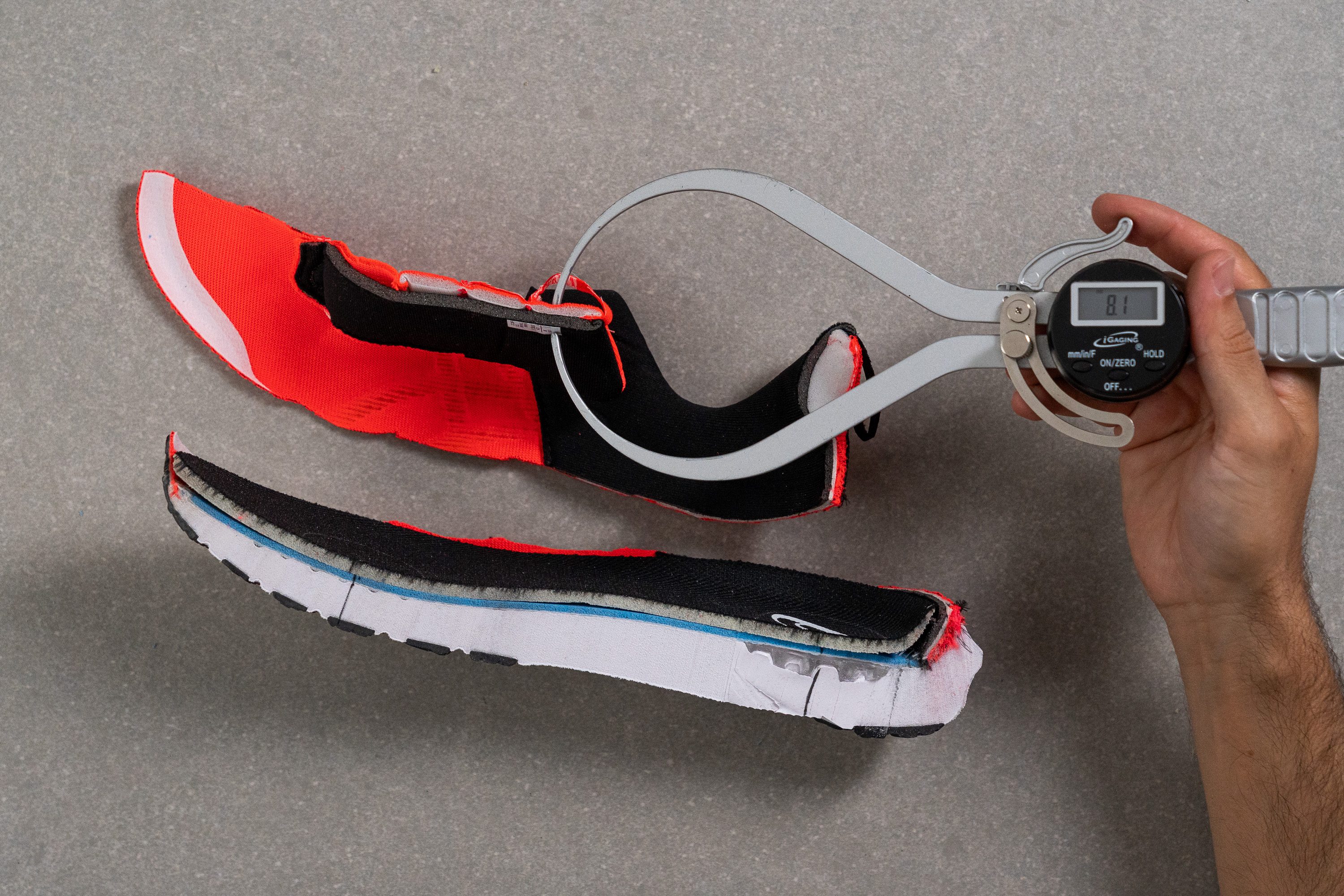
| GT 1000 14 | 8.1 mm |
| Average | 5.8 mm |
Tongue: gusset type
Another common omission in budget-conscious shoes is the gusseted tongue, often reserved for higher-tier models. The GT 1000 14 still doesn't feature a tongue stitched to the sides... maybe that's something we'll see in the v15.
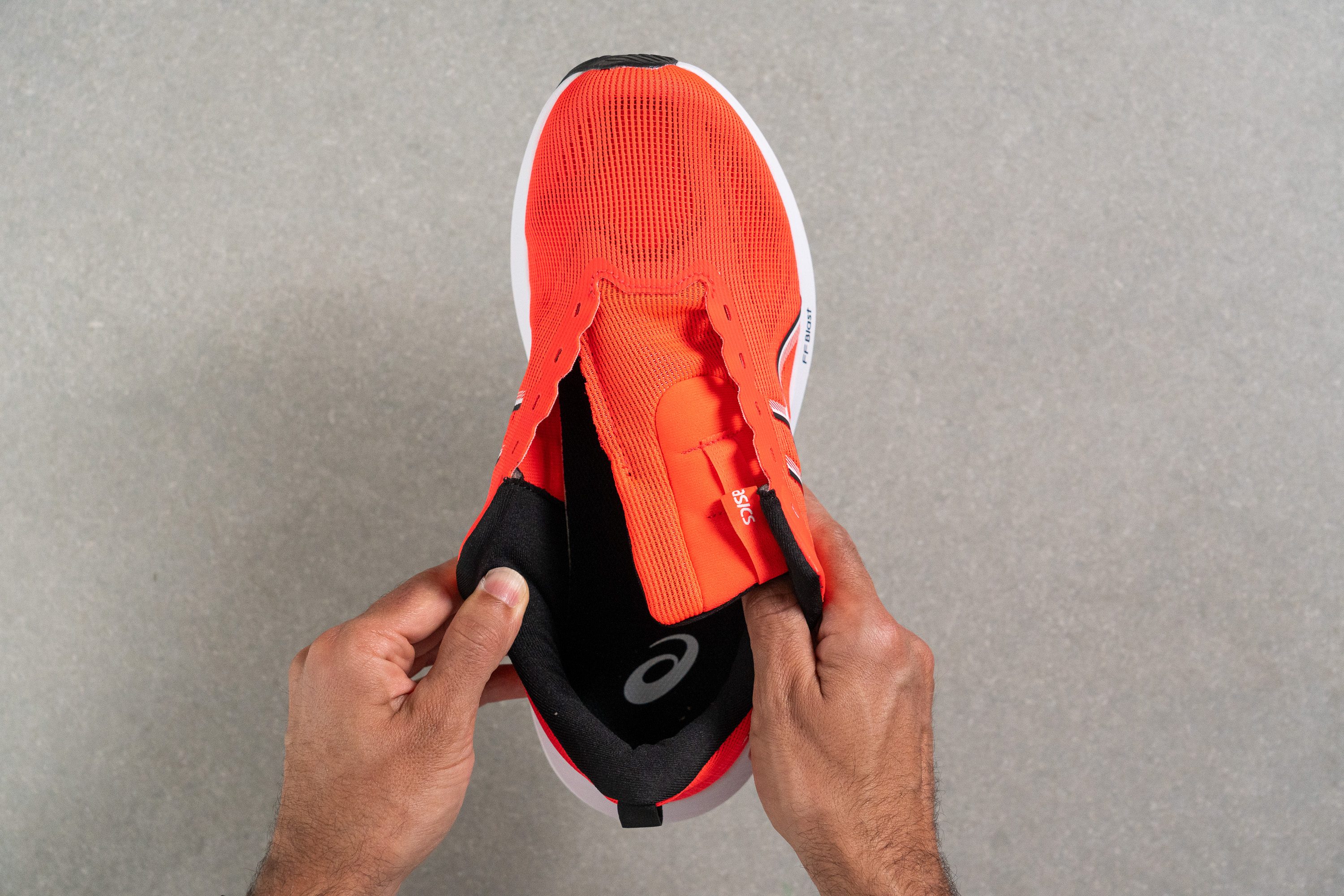
| GT 1000 14 | None |
Price
One of the main draws of the GT 1000 14 is its wallet-friendly price, sitting below the rest of ASICS' stability lineup. For runners who don't need premium materials or peak performance, it's a solid bang-for-your-buck option.
| GT 1000 14 | $110 |
Heel tab
One of the small design tweaks from v13 is the addition of a heel tab that improves both functionality and aesthetics.
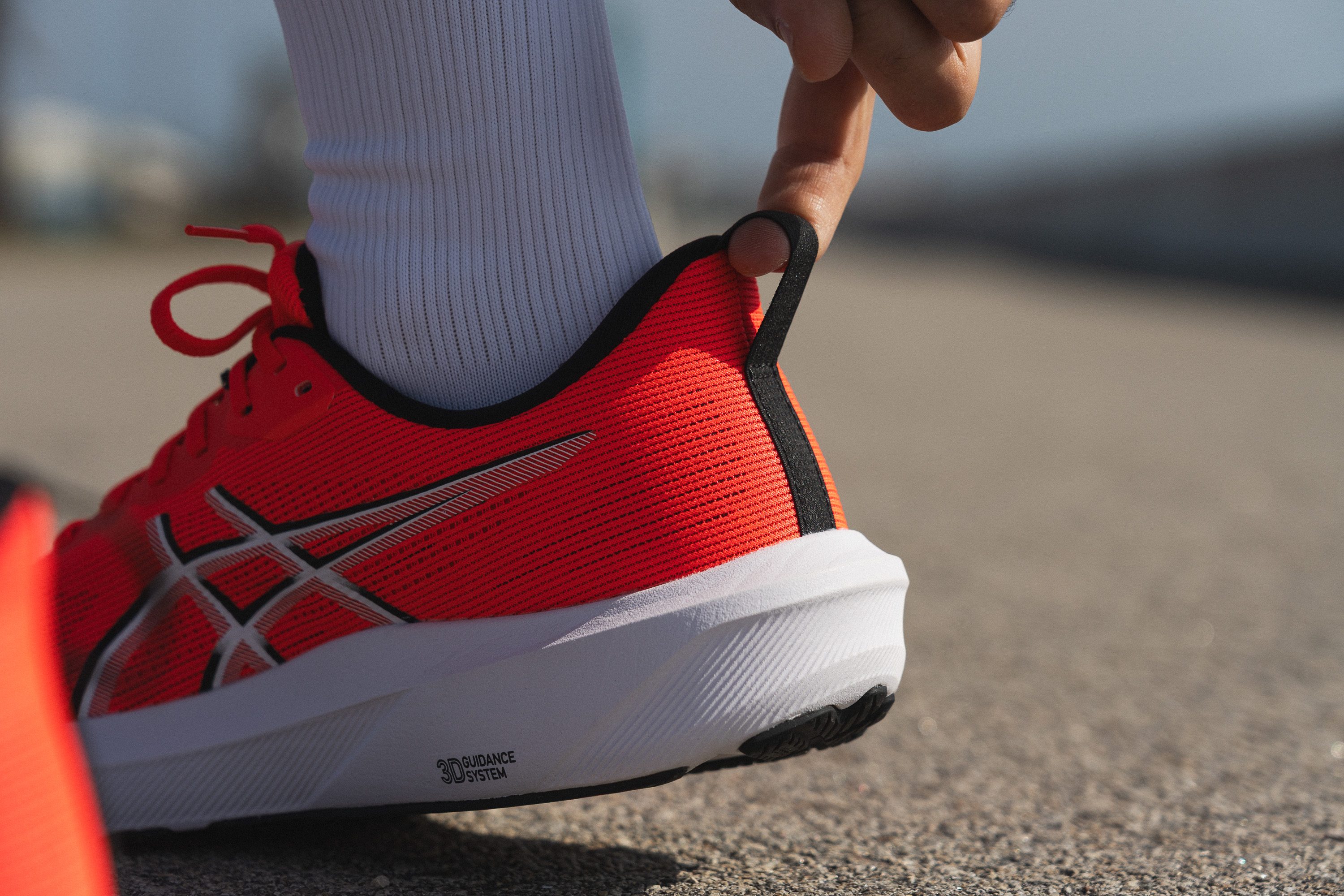
| GT 1000 14 | Finger loop |

